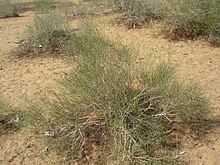Calligonum
| Calligonum | |
|---|---|

| |
| Calligonum polygonoides | |
| Scientific classification | |
| Kingdom: | Plantae |
| Clade: | Tracheophytes |
| Clade: | Angiosperms |
| Clade: | Eudicots |
| Order: | Caryophyllales |
| Family: | Polygonaceae |
| Subfamily: | Polygonoideae |
| Genus: | Calligonum L. |
| Species | |
|
See text | |
Calligonum is a genus of plants in the family Polygonaceae with about 80 species across the Mediterranean Sea region, Asia and North America.
Description
Plants of the genus Calligonum are shrubs, diffusely but irregularly branched, with flexuous woody branches. Leaves are simple, opposite, nearly sessile, linear or scale-like, sometimes absent or very small, linear or filiform, distinct or united with short membranous ochreae. Flowers are bisexual, solitary or in loose axillary inflorescences. Flowers have persistent, 5-parted
Taxonomy
The genus Calligonum was first published by Carl Linnaeus in 1753.[3] It is placed in the subfamily Polygonoideae, tribe Calligoneae, along with its sister genus, Pteropyrum.[4]
Species
- Calligonum acanthopterum I.G.Borshch.
- Calligonum alatosetosum Maassoumi & Kazempour
- Calligonum aphyllum (Pall.) Gürke
- Calligonum arborescens Litv.
- Calligonum azel Maire
- Calligonum babakianum Godw.
- Calligonum bakuense Litv.
- Calligonum bucocladum Bunge
- Calligonum bykovii Godw.
- Calligonum calvescens Maire
- Calligonum caput-medusae Schrenk
- Calligonum crinitum Boiss.
- Calligonum crispum Bunge
- Calligonum cristatum Bunge
- Calligonum ebinuricum N.A.Ivanova ex Soskov
- Calligonum eriopodum Bunge
- Calligonum junceum (Fisch. & C.A.Mey.) Litv.
- Calligonum klementzii Losinsk.
- Calligonum laristanicum Rech.f. & Schiman-Czeika
- Calligonum leucocladum (Schrenk) Bunge
- Calligonum litwinowii Drobow
- Calligonum macrocarpum I.G.Borshch.
- Calligonum matteianum Drobow
- Calligonum mejidumAl-Khayat
- Calligonum microcarpum I.G.Borshch.
- Calligonum mongolicum Turcz.
- Calligonum murex Bunge
- Calligonum polygonoides L.
- Calligonum rubicundum Bunge
- Calligonum santoanum Korovin
- Calligonum schizopterum Rech.f. & Schiman-Czeika
- Calligonum setosum (Litv.) Litv.
- Calligonum spinosetosum Maassoumi & Batooli
- Calligonum taklimakanense B.R.Pan & K.M.Shen
- Calligonum tetrapterum Jaub. & Spach
- Calligonum trifarium Z.M.Mao
- Calligonum triste Litv.
- Calligonum turbineum Pavlov
References
- ^ "Calligonum". Flora of Pakistan. Retrieved 2013-11-23 – via eFloras.org, Missouri Botanical Garden, St. Louis, MO & Harvard University Herbaria, Cambridge, MA.
- ^ "Calligonum". Flora of China. Retrieved 2013-11-23 – via eFloras.org, Missouri Botanical Garden, St. Louis, MO & Harvard University Herbaria, Cambridge, MA.
- ^ "Calligonum L." International Plant Names Index (IPNI). Royal Botanic Gardens, Kew; Harvard University Herbaria & Libraries; Australian National Botanic Gardens. Retrieved 2019-03-08.
- doi:10.12705/646.5
Wikimedia Commons has media related to Calligonum.
